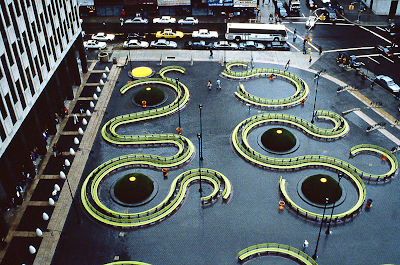Junkspace is everywhere
Defining junkspace is difficult to accomplish. I don't think that just because a something is replaceable automatically qualifies it as "junk". Architecture doesn't need to last for centuries to be considered quality. But junkspace does seem to be every now. It's a product of efficiency that has made architecture lazy and boring, especially in commercial districts of high density. I think part of this stems from the desire to build things as cheap and as quick as possible. But I think a bigger reason is not fully keeping the user in mind or allowing them to participate in the design process. An example of public junkspace can be seen in the Javits Plaza in New York City designed by Martha Schwartz. It's a series of winding benches that force users to sit in circles and look at each other. It doesn't exist today because it proved an unpopular and unused space, partly because the users of the plaza didn't have any input in the design, and found it an uncomfortable place to occupy.
The plaza itself can be considered inherent junkspace because this wasn't the first time a project on it was removed. The plaza once had a controversial art installation by Richard Serra that was seen as ugly and obtrusive. Koolhaas' style when he wrote his essay on Junkspace seemed almost suffocating and choatic and uncomfortable. Public space needs room to breathe. It appears there is an inherent need to cram things into public open spaces, regardless of what actually needs to be there, even if the best option is to keep it left open.
When masterplanning something like a mall or shopping center or even a suburb, everything is planned from day one, allowing no room for natural growth or evolution. Public spaces are forced into areas, rather than letting pedestrians occupy them naturally. My favorite example of this is when Universities down't plan where there sidewalks go, but wait until desire lines marked into the grass form by the students' paths. The users ultimately decide where the public space is between the buildings rather than the developers.




I partially agree with this in the sense that I think that users should be the factors in which spaces are designed. When you say that the user decides rather than the developer, I think that the architect should decide along side or instead of the user. Isn't that our job? Although, unfortunately developers win out most of the time because they're the ones with money....
ReplyDeleteI like your case study and agree that the user should be a bigger influence in the earliest phases of design. Too often are architects and planners trying to alter the way the user interacts with the space, in some ways changing human nature. However it would seem that in the case of the Javits Plaza, society did not respond as Martha Schwartz intended. Had she been more considerate of the users and designed to their own interests, perhaps the plaza could have been a more successful space.
ReplyDelete